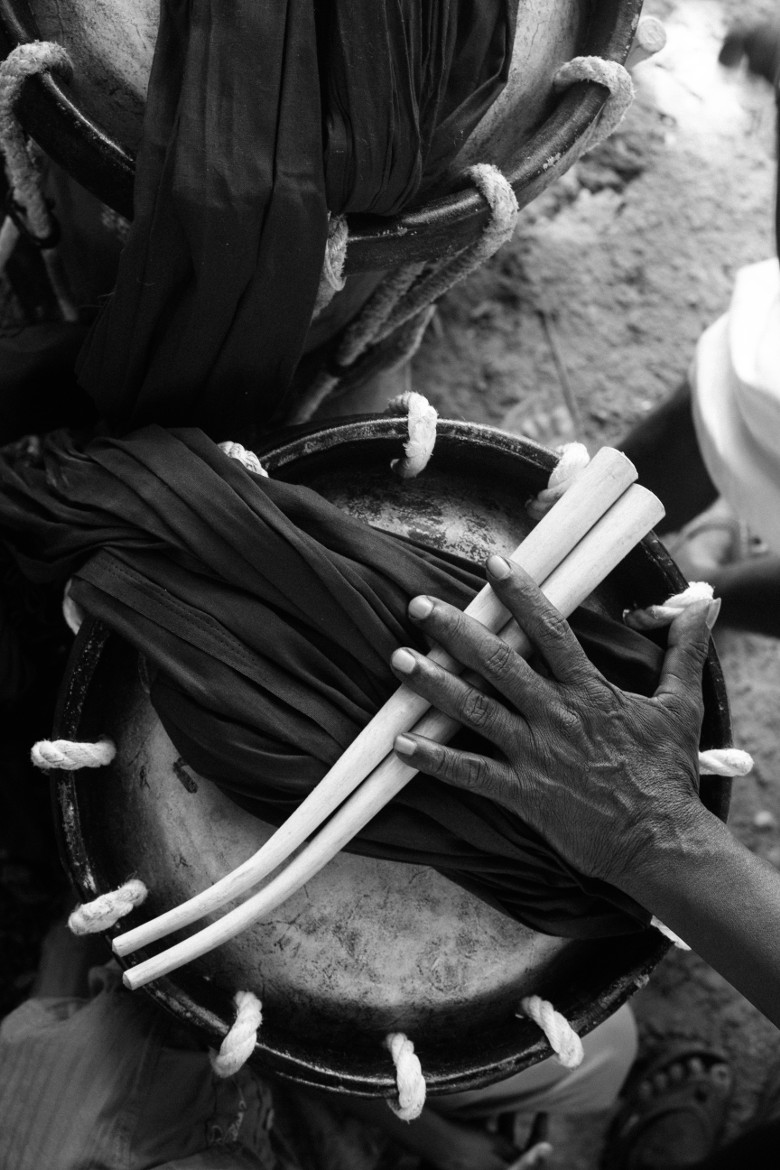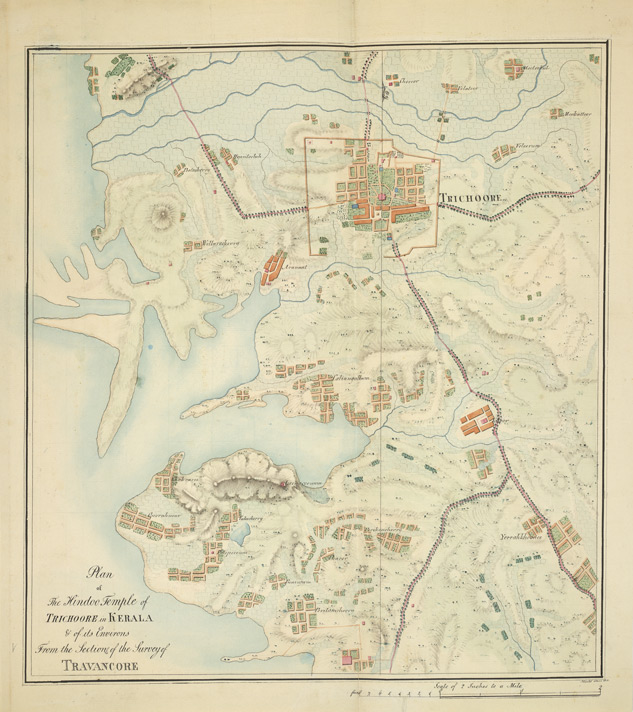|
Malavazhiyattam
Malavazhiyattam also known as Malavayiyattam Kariniliyattam or Cheruniliyattam is a ritualistic folk art of the Paraya community in Kerala, India. It is music and drama performed to please Malavazhi, a mother goddess worshiped by the Parayas and installed in their homes. Myth During the Devasura war, the defeated devas took shelter of Lord Shiva. One of the Asuras shot an arrow at Shiva who was performing penance for the victory of the devas. Malavazhi and Mookan Chatan are siblings who emerged from the third eye of Lord Shiva, who opened his eyes in anger at the interruption of his penance. Malavazhi is also called Cherunili and Karineeli and Mookan Chatan is called Mani and Muthappan. Karineeli and Mani, who went to the devaloka to find out who their father was, were chased away by the devas. They left devaloka and spent their childhood in Kalladikode Malavara, famous for ancient magic. Walking around there, once they met Shiva requested him to accept their paternity and show ... [...More Info...] [...Related Items...] OR: [Wikipedia] [Google] [Baidu] |
Paraiyar
Paraiyar, Parayar or Maraiyar (formerly anglicised as Pariah and Paree) is a caste group found in the Indian states of Tamil Nadu and Kerala and in Sri Lanka. Etymology Robert Caldwell, a nineteenth-century missionary and grammarian who worked in South India, was in agreement with some Indian writers of the same period who considered the name to derive from the Tamil word '' parai'' (''drum''). According to this hypothesis, the Paraiyars were originally a community of drummers who performed at auspicious events like weddings and funerals. M. Srinivasa Aiyangar, writing a little later, found this etymology unsatisfactory, arguing that beating of drums could not have been an occupation of so many people. Sociologist Karthikeyan Damodaran also challenges the notion that the Paraiyars were primarily drum beaters, arguing they are the largest caste group in Tamil Nadu and engaged in diverse occupations like agriculture and weaving. He contends that the name's history is misle ... [...More Info...] [...Related Items...] OR: [Wikipedia] [Google] [Baidu] |
Chenda
The Chenda (, ) is a cylindrical percussion instrument originating in the state of Kerala and widely used in Tulu Nadu of Karnataka in India. In Tulu Nadu (Coastal Karnataka), it is known as ''chende''. The instrument is strongly associated with the cultural identity of both Kerala and Tulu Nadu. Traditionally, it is used by the Malayar ethnic groups in Kerala. According to their mythology, Lord Shiva blessed them with both the chenda and Witchcraft, matravadham, which are considered synonymous in their mantravadha tradition, where sound plays a central role. This instrument is famous for its loud and rigid sound. A Chenda has two sides, the left side called "Edamthala" (ഇടം തല)(Left Head) and the right side "Valamthala" (വലം തല)(Right Head). The "Edamthala" is made of only one/two layer of cow skin and the "Valamthala" will have a five/seven layer skin, so as to have a Bass (sound), bass sound. The skin are dried in the shade and fastened on wooden rin ... [...More Info...] [...Related Items...] OR: [Wikipedia] [Google] [Baidu] |
Bhagavan
The word Bhagavan (; ), also spelt as Bhagwan (sometimes translated in English as "Lord", "God"), is an epithet within Indian religions used to denote figures of religious worship. In Hinduism it is used to signify a deity or an ''avatar'', particularly for Krishna and Vishnu in Vaishnavism, Shiva in Shaivism and Durga or Adi Shakti in Shaktism.James Lochtefeld (2000), "Bhagavan", The Illustrated Encyclopedia of Hinduism, Vol. 1: A–M, Rosen Publishing. , page 94Friedhelm Hardy (1990), The World's Religions: The Religions of Asia, Routledge, , pages 79-83 In Jainism the term refers to the Tirthankaras, and in Buddhism to the Buddha. In many parts of India and South Asia, Bhagavan represents the concept of a universal God or Divine to Hindus who are spiritual and religious but do not worship a specific deity. In '' bhakti'' school literature, the term is typically used for any deity to whom prayers are offered. A particular deity is often the devotee's one and only Bhagavan ... [...More Info...] [...Related Items...] OR: [Wikipedia] [Google] [Baidu] |
Regional Hindu Gods
In geography, regions, otherwise referred to as areas, zones, lands or territories, are portions of the Earth's surface that are broadly divided by physical characteristics (physical geography), human impact characteristics (human geography), and the interaction of humanity and the environment ( environmental geography). Geographic regions and sub-regions are mostly described by their imprecisely defined, and sometimes transitory boundaries, except in human geography, where jurisdiction areas such as national borders are defined in law. More confined or well bounded portions are called ''locations'' or ''places''. Apart from the global continental regions, there are also hydrospheric and atmospheric regions that cover the oceans, and discrete climates above the land and water masses of the planet. The land and water global regions are divided into subregions geographically bounded by large geological features that influence large-scale ecologies, such as plains and features. As a ... [...More Info...] [...Related Items...] OR: [Wikipedia] [Google] [Baidu] |
Hinduism In Kerala
Hinduism is the largest religion in Kerala and Hindu lineages together make up 54.7% of the population of the state according to the 2011 Census of India, 2011 census. Background Hinduism is the most widely professed faith in Kerala. According to 2011 Census of India figures, 54.7% of Kerala's residents are Hindus. Hindus represent the biggest religious group in all districts except Malappuram district, Malappuram. The legends regarding the origin of Kerala are Hindu in nature. Kerala produced several saints and movements. Adi Shankara was a religious philosopher who contributed to Hinduism and propagated the philosophy of Advaita. He was instrumental in establishing four mathas at Sringeri, Dwarka, Puri and Jyotirmath. Melpathur Narayana Bhattathiri was another religious figure who composed Narayaniyam, a collection of verses in praise of the Hindu God Krishna. Various practises of Hinduism are unique to Kerala. Worship of Shiva and Vishnu is popular in Kerala. Lord Kri ... [...More Info...] [...Related Items...] OR: [Wikipedia] [Google] [Baidu] |
Dances Of Kerala
Dance is an The arts, art form, consisting of sequences of body movements with aesthetic and often Symbol, symbolic value, either improvised or purposefully selected. Dance can be categorized and described by its choreography, by its repertoire of movements or by its History of dance, historical period or List of ethnic, regional, and folk dances by origin, place of origin. Dance is typically performed with Music, musical accompaniment, and sometimes with the dancer simultaneously using a musical instrument themselves. Two common types of group dance are Concert dance, theatrical and Participation dance, participatory dance. Both types of dance may have special functions, whether social, ceremonial, Competitive dance, competitive, Erotic dance, erotic, War dance, martial, Sacred dance, sacred or Liturgical dance, liturgical. Dance is not solely restricted to performance, as dance is used as a form of exercise and occasionally training for other sports and activities. Dance perf ... [...More Info...] [...Related Items...] OR: [Wikipedia] [Google] [Baidu] |
Ritual Dances
{{Disambiguation ...
Ceremonial dance may refer to: *Sacred dance *Ecstatic dance *Folk dance A folk dance is a dance that reflects the life of the people of a certain country or region. Not all ethnic dances are folk dances. For example, Ritual, ritual dances or dances of ritual origin are not considered to be folk dances. Ritual dances ... [...More Info...] [...Related Items...] OR: [Wikipedia] [Google] [Baidu] |
Silambu
Silambu (; /cil’əmpɨ̆/), or Gaggara ( Tulu: ಗಗ್ಗರ), is an anklet worn and used in a variety of contexts on the Indian subcontinent. Etymology According to Jeyaraj, the word 'silambu' is derived from the verb 'silambal', meaning 'to make sound'. Description The silambu is a hollow anklet filled with beads that produce noise when the wearer moves or dances. It may be worn on the ankle or the leg. When worn on the leg, it is termed ''kālchilambu'' in Tamil. Some varieties of silambu are made of copper and use iron balls to produce sound. Others are made of silver. Importance In dance Nautch performers wore silambu. Kandyan dancers may wear silambu. In art and literature Shiva in his dancing pose nataraja sometimes wears a silambu on his ankle. The epic ''Silappatikaram'' is structured around the character Kannaki's attempt to sell her silambu, and takes its title from the name of the anklet. In religion and rituals Silambu are sometimes placed on ... [...More Info...] [...Related Items...] OR: [Wikipedia] [Google] [Baidu] |
Thrissur District
Thrissur (), anglicised as Trichur, is one of the List of districts of Kerala, 14 districts in the States and union territories of India, Indian state of Kerala. It is situated in the central region of the state. Spanning an area of about , the district is home to over 9% of Kerala's population. Thrissur district is bordered by the districts of Palakkad district, Palakkad and Malappuram district, Malappuram to the north, the districts of Ernakulam district, Ernakulam and Idukki District, Idukki to the south and Coimbatore district, Coimbatore to the east. The Arabian Sea lies to the west and Western Ghats stretches towards the east. It is part of the historical Malabar Coast, which has been trading internationally since ancient times. The main language spoken is Malayalam language, Malayalam. Thrissur district was formed on 1 July 1949, with the headquarters at Thrissur City. Thrissur is known as the cultural capital of Kerala, and the land of Poorams. The district is known ... [...More Info...] [...Related Items...] OR: [Wikipedia] [Google] [Baidu] |
Parvati
Parvati (, , IPA: /Sanskrit phonology, pɑɾʋət̪iː/), also known as Uma (, , IPA: Sanskrit phonology, /ʊmɑː/) and Gauri (, , IPA: /Sanskrit phonology, gə͡ʊɾiː/), is one of the principal goddesses in Hinduism, revered as the Devi, goddess of power, energy, nourishment, harmony, love, beauty, devotion, and motherhood. Along with Lakshmi and Saraswati, Sarasvati, she forms the trinity, known as the Tridevi. From her first appearance as a goddess during the Itihasa-Purana, epic period (400 BCE – 400 CE), Parvati is primarily depicted as the consort of the god Shiva. According to various Puranas, Parvati is the reincarnation of Sati (Hindu goddess), Sati, Shiva's first wife, who relinquished her body to sever familial ties with her father, Daksha, after he had insulted Shiva. Parvati is often equated with the other goddesses such as Sati, Uma, Kali and Durga and due to this close connection, they are often treated as one and the same, with their stories frequently ove ... [...More Info...] [...Related Items...] OR: [Wikipedia] [Google] [Baidu] |
Mantra
A mantra ( ; Pali: ''mantra'') or mantram (Devanagari: मन्त्रम्) is a sacred utterance, a numinous sound, a syllable, word or phonemes, or group of words (most often in an Indo-Iranian language like Sanskrit or Avestan) believed by practitioners to have religious, magical or spiritual powers. Feuerstein, Georg (2003), ''The Deeper Dimension of Yoga''. Shambala Publications, Boston, MA Some mantras have a syntactic structure and a literal meaning, while others do not. ꣽ, ॐ (Aum, Om) serves as an important mantra in various Indian religions. Specifically, it is an example of a seed syllable mantra ( bijamantra). It is believed to be the first sound in Hinduism and as the sonic essence of the absolute divine reality. Longer mantras are phrases with several syllables, names and words. These phrases may have spiritual interpretations such as a name of a deity, a longing for truth, reality, light, immortality, peace, love, knowledge, and action. Examples of lo ... [...More Info...] [...Related Items...] OR: [Wikipedia] [Google] [Baidu] |






